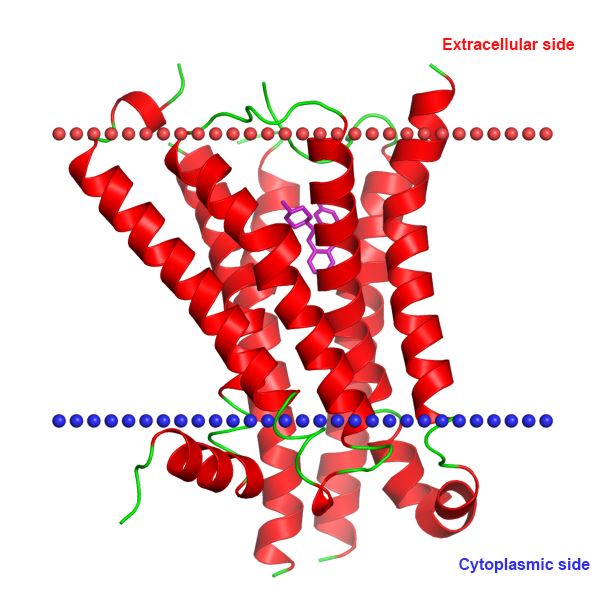Introduction of HTR1E
5-hydroxytryptamine receptor 1E, alternatively known as serotonin receptor 1E, is one of the subtypes for serotonin receptor (5-HT receptor) and in human is encoded by HTR1E gene. HTR1E is highly expressed in the human brain. Specifically, it was detected in the adventitial layer of cerebral arteries but not in the microvasculature, venous tissue or other brain arteries. The presence of HTR1E in brain areas involved in memory suggests that they might play a role in memory.
| Basic Information of HTR1E | |
| Protein Name | 5-hydroxytryptamine receptor 1E |
| Gene Name | HTR1E |
| Aliases | 5-HT1E |
| Organism | Homo sapiens (Human) |
| UniProt ID | P28566 |
| Transmembrane Times | 7 |
| Length (aa) | 365 |
| Sequence |
MNITNCTTEASMAIRPKTITEKMLICMTLVVITTLTTLLNLAVIMAIGTTKKLHQPANYLICSLAVTDLLV AVLVMPLSIIYIVMDRWKLGYFLCEVWLSVDMTCCTCSILHLCVIALDRYWAITNAIEYARKRTAKRAALM ILTVWTISIFISMPPLFWRSHRRLSPPPSQCTIQHDHVIYTIYSTLGAFYIPLTLILILYYRIYHAAKSLY QKRGSSRHLSNRSTDSQNSFASCKLTQTFCVSDFSTSDPTTEFEKFHASIRIPPFDNDLDHPGERQQISST RERKAARILGLILGAFILSWLPFFIKELIVGLSIYTVSSEVADFLTWLGYVNSLINPLLYTSFNEDFKLAF KKLIRCREHT |
Function of HTR1E Membrane Protein
HTR1E (5-HT1E) functions as a G-protein coupled receptor for the neurotransmitter serotonin (5-hydroxytryptamine, 5-HT). It can also act as a receptor for various alkaloids and psychoactive substances. The interaction with its ligand 5-hydroxytryptamine (serotonin), 5-HT1E induces a conformation change that triggers signaling via guanine nucleotide-binding proteins (G proteins) and regulates the activity of downstream effectors, such as adenylate cyclase. 5-HT1E activation leads to inhibition of adenylate cyclase activity. The stimulation of 5-HT1E and subsequent inhibition of adenylate cyclase activity in the dentate gyrus (DG) indicate that 5-HT1E may mediate regulation of hippocampal activity by 5-HT, making it a possible drug target for the treatment of neuropsychiatric disorders characterized by memory deficits (such as Alzheimer's disease) or as a target for the treatment of temporal lobe epilepsy.
 Fig.1 Structure of 5-HT1E membrane protein.
Fig.1 Structure of 5-HT1E membrane protein.
Application of HTR1E Membrane Protein in Literature
In the study, the stimulation of 5-ht(1E) receptors and subsequent inhibition of adenylate cyclase activity in the DG suggest that 5-ht(1E) receptors may mediate regulation of hippocampal activity by 5-HT, making it a possible drug target for the treatment of neuropsychiatric disorders characterized by memory deficits (such as Alzheimer's disease) or as a target for the treatment of temporal lobe epilepsy.
This study reveals the differences between tryptamine binding requirements of 5-HT1Es and 5-HT1Fs. The insights generated from this study will inform future drug development and molecular modeling studies for both 5-HT(1E) and 5-HT(1F) receptors.
The results of this article indicate that using the guinea pig as an animal model should provide important insights into possible functions of this receptor and the therapeutic potential of selective human 5-HT(1E) drugs.
This study assesses the possible antinociceptive role of peripheral 5-HT(1) receptor subtypes in the rat formalin test and suggests that the use of selective 5-HT(1) receptor agonists could be a therapeutic strategy to reduce inflammatory pain.
HTR1E Preparation Options
To meet your specific requirements, we present robust reconstitution forms as well as multiple active formats for membrane proteins. Our efficient Magic™ membrane protein production platform allows many flexible options, from which you can always find the most appropriate one for your project. Aided by our versatile Magic™ anti-membrane protein antibody discovery platform, we also provide customized anti-HTR1E antibody development services.
Creative Biolabs has worked all out in the field of membrane protein preparation to support membrane protein studies. Our experienced scientists will spare no effort to advance their research and programs of membrane protein preparation. Please feel free to contact us for more details.
All listed services and products are For Research Use Only. Do Not use in any diagnostic or therapeutic applications.